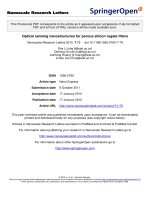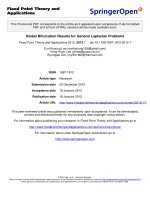Báo cáo toán học: " Fixed point theorems for w-cone distance contraction mappings in tvs- cone metric spaces" docx
Bạn đang xem bản rút gọn của tài liệu. Xem và tải ngay bản đầy đủ của tài liệu tại đây (273.26 KB, 13 trang )
This Provisional PDF corresponds to the article as it appeared upon acceptance. Fully formatted
PDF and full text (HTML) versions will be made available soon.
Fixed point theorems for w-cone distance contraction mappings in tvs- cone
metric spaces
Fixed Point Theory and Applications 2012, 2012:3 doi:10.1186/1687-1812-2012-3
Ljubomir Ciric ()
Hossein Lakzian ()
Vladimir Rakocevic ()
ISSN 1687-1812
Article type Research
Submission date 11 April 2011
Acceptance date 4 January 2012
Publication date 4 January 2012
Article URL />This peer-reviewed article was published immediately upon acceptance. It can be downloaded,
printed and distributed freely for any purposes (see copyright notice below).
For information about publishing your research in Fixed Point Theory and Applications go to
/>For information about other SpringerOpen publications go to
Fixed Point Theory and
Applications
© 2012 Ciric et al. ; licensee Springer.
This is an open access article distributed under the terms of the Creative Commons Attribution License ( />which permits unrestricted use, distribution, and reproduction in any medium, provided the original work is properly cited.
Fixed point theorems for w-cone distance contraction
mappings in tvs-cone metric spaces
Ljubomir
´
Ciri´c
∗1
, Hossein Lakzian
2
and Vladimir Rakoˇcevi´c
3
1
Faculty of Mechanical Engineering, Kraljice Marije 16, Belgrade, Serbia
2
Department of Mathematics, Payame Noor University, 19395-4697 Tehran, Islamic Republic of Iran
3
Faculty of Sciences and Mathematics, University in Niˇs, Visegradska 33, Niˇs, Serbia
∗
Corresponding author:
Email addresses:
HL: h
VR:
Email:
∗
Corresponding author
Abstract
In this article, we introduce the concept of a w-cone distance on topological vector space (tvs)-cone metric
spaces and prove various fixed point theorems for w-cone distance contraction mappings in tvs-cone
metric spaces. The techniques of the proof of our theorems are more complex then in the corresponding
previously published articles, since a new technique was necessary for the considered class of mappings.
Presented fixed point theorems generalize results of Suzuki and Takahashi, Abbas and Rhoades, Pathak
and Shahzad, Raja and Veazpour, Hicks and Rhoades and several other results existing in the literature.
Mathematics subject classification (2010): 47H10; 54H25.
Keywords: fixed point; w-distance; tvs cone metric.
1 Introduction and preliminaries
There exist many generalizations of the concept of metric spaces in the literature. Fixed point
theory in abstract metric or K-metric spaces was developed in the middle of 70th years of twentieth
century. Huang and Zhang [1] re-introduced and studied the concept of cone metric spaces over a
1
Banach space, and proved several fixed point theorems. Then, there have been a lot of articles in
which known fixed point theorems in metric are extended to cone metric spaces. Recently, Du [2]
used the scalarization function and investigated the equivalence of vectorial versions of fixed point
theorems in K-metric spaces and scalar versions of fixed point theorems in metric spaces. He showed
that many of the fixed point theorems for mappings satisfying contractive conditions of a linear type
in K-metric spaces can be considered as corollaries of corresponding theorems in metric spaces.
Nevertheless, the fixed point theory in K-metric spaces proceeds to be actual, since the method of
scalarization function cannot be applied for a wide class of weakly contractive mapping, satisfying
nonlinear contractive conditions.
Kada et al. [3] introduced and studied the concept of w-distance on a metric space. They
give examples of w-distance and improved Caristi’s fixed point theorem, Ekeland’s -variational’s
principle and the nonconvex minimization theorem according to Takahashi (see many useful examples
and results on w-distance in [4–8] and in references there in).
Definition 1. [3]. Let X be a metric space with metric d. Then a function p : X × X → [0, ∞) is
called a w-distance on X if the following are satisfied:
(1) p(x, z) ≤ p(x, y) + p(y, z), for any x, y, z ∈ X,
(2) for any x ∈ X, p(x, ·) : X → [0, ∞) is lower semicontinuous,
(3) for any > 0, there exist δ > 0 such that p(z, x) ≤ δ and p(z, y) ≤ δ imply d(x, y) ≤ .
In the following we suppose that E is a real Hausdorff topological vector space (tvs for short)
with the zero vector θ. A proper nonempty and closed subset P of E is called a (convex) cone if
P + P ⊂ P , λP ⊂ P for λ ≥ 0 and P ∩ (−P ) = θ. We shall always assume that the cone P has a
nonempty interior int P (such cones are called solid).
Each cone P induces a partial order on E by x y ⇔ y − x ∈ P . x ≺ y will stand for x y
and x = y, while x y will stand for y − x ∈ int P . The pair (E, P ) is an ordered tvs.
Let us recall that the algebraic operations in tvs-cone are continuous functions. For the conve-
nience of the reader we give the next result.
Lemma 2. Let E be a tvs over F = R, C.
(1) Suppose that x
n
, y
n
, x, y ∈ E and x
n
→ x and y
n
→ y. Then x
n
+ y
n
→ x + y.
(2) Suppose that x
n
, x ∈ E, λ
n
, λ ∈ F, x
n
→ x and λ
n
→ λ. Then λ
n
x
n
→ λx.
Proof. (1) Suppose that W ⊂ E is an open set and x + y ∈ W . Let us define f : E × E → E by
f(u, v) = u + v, u, v ∈ E. Because f is continuous at (x, y) there is an open set G ⊂ E × E such that
2
(x, y) ∈ G and f(G) ⊂ W . Now there are open sets U
i
, V
i
⊂ E, i ∈ I, such that G = ∪
i∈I
U
i
× V
i
.
Hence, there exists i
0
∈ I such that (x, y) ∈ U
i
0
× V
i
0
. Because x ∈ U
i
0
and x
n
→ x, there exists
n
1
such that x
n
∈ U
i
0
for all n ≥ n
1
. Also, because y ∈ V
i
0
and y
n
→ y, there exists n
2
such that
y
n
∈ V
i
0
for all n ≥ n
2
. Hence, x
n
+ y
n
= f(x
n
, y
n
) ∈ f(U
i
0
× V
i
0
) ⊂ W for all n ≥ max{n
1
, n
2
}.
Thus, x
n
+ y
n
→ x + y.
(2) Suppose that W ⊂ E is an open set and λx ∈ W . Let us define g : F × E → E by g(µ, v) =
µv, µ ∈ F, v ∈ E. Because g is continuous at (λ, x) there is an open set G ⊂ F × E such that
(λ, x) ∈ G and g(G) ⊂ W. Now there are open sets U
i
⊂ F, V
i
⊂ E, i ∈ I, such that G = ∪
i∈I
U
i
×V
i
.
Hence, there exists i
0
∈ I such that (λ, x) ∈ U
i
0
× V
i
0
. Because λ ∈ U
i
0
and λ
n
→ λ, there exists
n
1
such that λ
n
∈ U
i
0
for all n ≥ n
1
. Also, because x ∈ V
i
0
and x
n
→ x, there exists n
2
such that
x
n
∈ V
i
0
for all n ≥ n
2
. Hence, λ
n
x
n
= g(λ
n
, x
n
) ∈ g(U
i
0
× V
i
0
) ⊂ W for all n ≥ max{n
1
, n
2
}.
Thus, λ
n
x
n
→ λx.
Following [1, 2, 9, 10] we give the following
Definition 3. Let X be a nonempty set and (E.P ) an ordered tvs. A function d : X × X → E is
called a tvs-cone metric and (X, d) is called a tvs-cone metric space if the following conditions hold:
(C1) θ d(x, y) for all x, y ∈ X and d(x, y) = θ if and only if x = y;
(C2) d(x, y) = d(y, x) for all x, y ∈ X;
(C3) d(x, z) d(x, y) + d(y, z) for all x, y, z ∈ X.
Let x ∈ X and {x
n
} be a sequence in X. Then, it is said that
(i) {x
n
} (tvs-cone) converges to x if for every c ∈ E with θ c there exists a natural number
n
0
such that d(x
n
, x) c for all n > n
0
; we denote it by lim
n→∞
x
n
= x or x
n
→ x as n → ∞;
(ii) {x
n
} is a (tvs-cone) Cauchy sequence if for every c ∈ E with 0 c there exists a natural
number n
0
such that d(x
m
, x
n
) c for all m,n > n
0
;
(iii) (X, d) is (tvs-cone) complete if every tvs-Cauchy sequence is (tvs) convergent in X.
Let (X, d) be a tvs-cone metric space. Then the following properties are often used (see e.g.,
[1, 2, 9–13]).
(p
1
) If u ≤ v and v w then u w.
(p
2
) If a ≤ b + c for each c ∈ int P then a ≤ b.
(p
3
) If a ≤ λa, where a ∈ P and 0 < λ < 1, then a = θ.
(p
4
) If ∈ int P , θ ≤ a
n
and a
n
→ θ, then there exists n
0
such that for all n > n
0
we have
a
n
.
3
2 w-Cone distance in tvs-cone metric spaces
Let (X, d) be a tvs-cone metric space. Then
(c
1
) T : X → X is continuous at x ∈ X if x
n
is a sequence in X and lim x
n
= x implies
T (x) = lim T (x
n
).
(c
2
) G : X → P is lower semicontinuous at x ∈ X if for any in E with θ , there is n
0
in N
such that
G(x) ≤ G(x
n
) + , for all n ≥ n
0
, (1)
whenever {x
n
} is a sequence in X and x
n
→ x.
(c
3
) For x ∈ X, T : X → X, O(x; ∞) = {x, T x, T
2
x, . . .} is called the orbit of x. G : X → P is
T -orbitally lower semicontinuous at x if for any in E with θ , there is n
0
in N such that (1 )
with x = u holds whenever x
n
∈ O(x; ∞) and x
n
→ u.
Observe that if in definitions (c
1
), (c
2
) and (c
3
) we have E = R, P = [0, ∞), x = |x|, x ∈ E,
then we get the well-known definitions of continuity, lower and T-orbitally lower semicontinuity.
Definition 4. Let (X, d) be a tvs-cone metric space. Then, a function p : X × X → P is called a
w-cone distance on X if the following are satisfied:
(w
1
) p(x, z) ≤ p(x, y) + p(y, z), for any x, y, z ∈ X,
(w
2
) for any x ∈ X, p(x, ·) : X → P is lower semicontinuous,
(w
3
) for any in E with θ , there is δ in E with θ δ, such that p(z, x) δ and p(z, y) δ
imply d(x, y) .
Example 5. Let (X, d) be a cone metric space. Then, a cone metric d is a w-cone distance p on
X.
Proof. Clearly, if p = d, a w-cone distance p satisfies (w
1
) and (w
3
). So we have only to prove
(w
2
). Suppose that x,y ∈ X, y
n
∈ X, y
n
→ y and in E with θ be arbitrary. Since y
n
→ y,
then there is n
0
in N such that d(y
n
, y) for all n ≥ n
0
. Define G(y) = d(x, y). Then we have
G(y) = d(x, y) ≤ d(x, y
n
) + d(y
n
, y) ≤ d(x, y
n
) + = G(y
n
) +
for all n ≥ n
0
. Therefore p(x, ·) = d(x, ·) is lower semicontinuous.
Remark 6. Wang and Guo [14] defined the concept of c-distance on a cone metric space in the sense
of Huang and Zhang [1], which is also a generalization of w-distance of Kada et al. [3]. They proved a
common fixed point theorem (Theorem 2.2) by using c-distance in a cone metric space (X, d), where
a cone P is normal with normal constant K. Now we shall present an example (Example 7 below),
4
which shows that there are cone metric spaces where underlying cone is not normed, and so theorems
of Wang and Guo [14] cannot be applied. On the other case, our presented fixed point theorems for
mappings under contractive conditions expressed in the terms of w-distance can be applied, although
the underlying cone is not normed.
Example 7. Let E = C[0, 1] be the Banach space of real-valued continuous functions with the usual
norm
||f(t) − g(t)|| = max
0≤t≤1
|f(t) − g(t)|
and let a cone P be defined by P = {f ∈ E : f (t) ≥ 0 for t ∈ [0, 1]} . This cone is normal
in the Banach-space topology on E. Let τ
∗
be the strongest locally convex topology on the linear
vector space E. Then, intP = ∅, but the cone P is not normal in the topology τ
∗
. Indeed, if we
suppose, to the contrary, that P is normal cone, then the topology τ
∗
is normed (see, e.g., [15]). But
if the cone of an ordered tvs is solid and normal, then such tvs must be an ordered normed space,
which is impossible because an infinite dimensional space with the strongest locally convex topology
cannot be metrizable (see, e.g., [13]). Let now X = [0, +∞) and d : X × X → (E, τ
∗
) be defined by
d(x, y)(t) = |x − y|.e
t
. Then (X, d) is a tvs-cone metric space over the non normedzable linear tvs
(E, τ
∗
).
The following lemma is crucial and is an extension of Lemma 1 in [3] for a w-metric distance to
a w-cone distance.
Lemma 8. Let (X, d) be a tvs-cone metric space and let p be a w-cone distance on X. Let {x
n
} and
{y
n
} be sequences in X, let {α
n
}with θ ≤ α
n
, and {β
n
} with θ ≤ β
n
, be sequences in E converging
to θ, and let x, y, z ∈ X. Then the following hold:
(i) If p(x
n
, y) ≤ α
n
and p(x
n
, z) ≤ β
n
for any n ∈ N, then y = z. In particular, if p(x, y) = θ
and p(x, z) = θ, then y = z.
(ii) If p(x
n
, y
n
) ≤ α
n
and p(x
n
, z) ≤ β
n
for any n ∈ N, then {y
n
} converges to z.
(iii) If p(x
n
, x
m
) ≤ α
n
for any n, m ∈ N with m > n, then {x
n
} is a Cauchy sequence.
(iv) If p(y, x
n
) ≤ α
n
for any n ∈ N, then {x
n
} is a Cauchy sequence.
Proof. We shall prove (ii). Let in E with θ be arbitrary. From (w
3
) of Definition 4 there is
δ in E with θ δ, such that p(x
n
, y
n
) δ and p(y
n
, z) δ imply d(y
n
, z) . Since α
n
→ θ and
β
n
→ θ, there is n
0
∈ N such that α
n
≤ δ and β
n
≤ δ for all n ≥ n
0
. Then for all n ≥ n
0
we have
p(x
n
, y
n
) ≤ α
n
δ and p(x
n
, z) ≤ β
n
δ.
5
Thus from (w
3
), d(y
n
, z) . Hence y
n
→ z as n → ∞. Similarly, following lines of the proof of
Lemma 1 in [3], one can prove (i), (iii) and (iv).
3 Fixed point theorems for w-cone distance contraction mappings in K-metric
spaces
We note that the method of Du [2] for cone contraction mappings cannot be applied for a w-cone
distance contraction mappings.
In the following theorem, which extends and improves Theorem 2 of [3] and Theorem 1 of [5],
we give an estimate for a w-cone distance p(x
n
, z) of an approximate value x
n
and a fixed point z.
Theorem 9. Let (X, d) be a complete tvs-cone metric space with w-cone distance p on X. Suppose
that for some 0 ≤ k < 1 a mapping T : X → X satisfies the following condition:
p(T x, T
2
x) ≤ kp(x, T x), for all x ∈ X. (2)
Assume that either of the following holds:
(i) If y = T y, there exists c ∈ int(P ), c = θ, such that
c p(x, y) + p(x, Tx), for all x ∈ X;
(ii) T is continuous.
Then, there exists z ∈ X, such that z = T z and
p(T
n
x, z) ≤
k
n
1 − k
· p(x, Tx) f or n ≥ 1. (3)
Moreover, if v = T v for some v ∈ X, then p(v, v) = θ.
Proof. Let x ∈ X and define a sequence {x
n
} by x
0
= x; x
n
= T
n
x for any n ∈ N. Then from (2)
we have, for any n ∈ N,
p(x
n
, x
n+1
) = p(Tx
n−1
, Tx
n
) ≤ kp(x
n−1
, x
n
) ≤ · · · ≤ k
n
p(x, Tx). (4)
Thus, if m > n, then from (w
1
) of Definition 4 and (4),
p(x
n
, x
m
) ≤ p(x
n
, x
n+1
) + · · · + p(x
m−1
, x
m
)
≤ k
n
p(x, Tx) + · · · + k
m−1
p(x, Tx) (5)
≤
k
n
1 − k
· p(x, Tx).
6
Hence, by (iii) of Lemma 8 with α
n
= [k
n
/(1 − k)] · p(x, T x), {x
n
} is a Cauchy sequence in X. Since
X is complete, {x
n
} converges to some point z ∈ X.
Now we shall prove the estimate (3). Define a function G : X → P by G(x) = p(x
n
, x), where
n is any fixed positive integer. Since x
n
→ z as n → ∞, from (w
2
) of Definition 4 and (2) we have
that for any in E with θ , there is m
0
in N such that
p(x
n
, z) ≤ p(x
n
, x
m
) + for m > m
0
.
Thus by (5) we get
p(x
n
, z) ≤
k
n
1 − k
· p(x, Tx) + . (6)
Hence, as x
n
= T
n
x,
p(T
n
x, z) ≤
k
n
1 − k
· p(x, Tx) + for any in E with θ .
Thus, taking = /i we have
p(T
n
x, z) ≤
k
n
1 − k
· p(x, Tx) +
i
for each i ≥ 1. (7)
From (7) and by definition of the partial order ≤ on E, we obtain
i
− p(T
n
x, z) +
k
n
1 − k
· p(u, Tu) ∈ P.
By Lemma 2, it is easy to show that
lim
i→∞
i
− p(T
n
x, z) +
k
n
1 − k
· p(u, Tu)
= −p(T
n
x, z) +
k
n
1 − k
· p(u, Tu).
Therefore, as P is closed,
−p(T
n
x, z) +
k
n
1 − k
· p(x, Tx) ∈ P. (8)
From the definition of partial order ≤, (8) is equivalent to (3). Thus we proved (3).
Suppose that the case (i) is satisfied. We have to prove that T z = z. Suppose, to the contrary,
that z = T z. Then from (i) there exists c ∈ int(P) such that
c p(x, z) + p(x, T x), for all x ∈ X. (9)
From (6) and (3) we conclude that there exists n
0
∈ N such that
p(x
n
, z)
c
4
and p(x
n
, x
n+1
)
c
4
for all n > n
0
. (10)
Since x
n
→ z as n → ∞, by (ii) of Definition 4 with x = x
n
0
, there exists m
0
> n
0
, such that Then
from (9) with x = x
n
, and from (10), we have
c p(x
n
, z) + p(x
n
, Tx
n
) = p(x
n
, z) + p(x
n
, x
n+1
) ≤
c
4
+
c
4
=
c
2
,
7
a contradiction, as c ∈int(P). Therefore, our assumption z = T z was wrong and so z = Tz.
If v = T v then we have,
p(v, v) = p(Tv, T
2
v) ≤ kp(v, T v) = k
n
p(v, v),
k
n
p(v, v) − p(v, v) ∈ P.
and by (p
3
) we have p(v, v) = 0.
If v = T v then we have, by using (4),
p(v, v) = p(T
n
v, T
n+1
v) = p(v
n
, v
n+1
) ≤ k
n
p(v, T v) = k
n
p(v, v). (11)
Hence
k
n
p(v, v) − p(v, v) ∈ P.
Since P is closed, by Lemma 2, we get
lim
n→∞
[k
n
p(v, v) − p(v, v)] = −p(v, v),
and P is closed, we get −p(v, v) ∈ P. Since also p(v, v) ∈ P, then p(v, v) = 0.
To complete the proof, we have to prove (ii). Suppose that T is continuous. Then from (c
1
),
as{x
n
} converge to z, we have
T (z) = lim
i→∞
T (x
n
) = lim
i→∞
x
n+1
= z.
Thus we proved that T(z) = z and so the proof is complete.
Now we shall present an example where our Theorem 9 can be applied, but the main Theorem
2.2 of Wang and Guo [14] cannot.
Example 10. Let X = [0, +∞) and d : X × X → (E, τ
∗
) be defined by d(x, y)(t) = |x − y|.e
t
, as
in Example 7 above. Then (X, d) is a tvs-cone metric space over the non-normed linear tvs (E, τ
∗
).
Define a mapping T : X → X by Tx = x/2. Then T satisfies the following condition:
p(T x, T
2
x) ≤
1
2
p(x, Tx), for all x ∈ X,
and if y = T y, there exists c ∈ int(P ), c = θ, such that
c p(x, y) + p(x, Tx), for all x ∈ X.
Thus all hypotheses of our Theorem 9 are satisfied and z = 0 is a fixed point of T . Note that the
mapping T : X → X satisfies the condition (2.1) in the main Theorem 2.2 of Wang and Guo [14]
with g(x) = x and a
1
= 1/2, a
2
= a
3
= a
4
= 0, but Theorem 2.2 cannot be applied since a cone P is
not normed.
8
The following corollary implies the recent result Theorem 3.5. of [4].
Corollary 11. Let (X, d) be a complete tvs-cone metric space with w−cone distance p on X and
0 ≤ r < 1/2. Suppose T : X → X and
p(T x, T
2
x) ≤ rp(x, T
2
x), for all x ∈ X. (12)
Assume that either (i) or (ii) of Theorem 9 holds. Then, there exists z ∈ X, such that z = Tz.
Moreover, if v = T v, then p(v, v) = θ.
Proof. Let x ∈ X. From (12) we have p(T x, T
2
x) ≤ rp(x, T
2
x) ≤ r[p(x, Tx) + p(T x, T
2
x)]. Hence
we get
p(T x, T
2
x) ≤ kp(x, T x),
where 0 ≤ k = r/(1 − r) < 1. Now, Corollary 11 follows from Theorem 9.
If f : X → X and F(f) is a set of all fixed points of f, then in a general case F(f ) = F (f
n
).
Abbas and Rhoades [11] studied cases when F (f ) = F (f
n
) for each n ∈ N, that is, when f has a
property P . The following theorem extends and improves Theorem 2 of [11].
Theorem 12. Let (X, d) be a complete tvs-cone metric space with w-cone distance p on X. Suppose
T : X → X satisfies the following condition:
p(T x, T
2
x) ≤ kp(x, T x), for all x ∈ X, (13)
where 0 ≤ k < 1, or T satisfies strict the inequality (13) with k = 1,for all x ∈ X with x = T x. If
F (T ) = ∅, then T has property P.
Proof. Let u ∈ F(T
n
) for some n > 1. Suppose that T satisfies (13). Then
p(u, Tu) = p(T
n
u, TT
n
u) ≤ kp(T
n−1
u, TT
n−1
u) ≤ · · · ≤ k
n
p(u, Tu). (14)
Similarly as from (11) we get p(v, v) = θ, from (14) we obtain p(u, T u) = θ. Then from (14),
p(T
i
u, T
i+1
u) ≤ k
i
p(u, Tu) = θ for all i ∈ N. Now, from (w
1
) of Definition 4 and T
n
u = u we get
p(u, u) ≤ p(u, T u) + p(T u, T
2
u) + · · · + p(T
n−1
u, T
n
u) = θ.
Thus p(u, u) = θ. Hence, and by (i) of Lemma 8 with x = u, y = T u and z = u, we have Tu = u.
Now suppose that T satisfies strict the inequality (13) with k = 1 and let u ∈ F (T
n
). If we suppose
that T u = u, then we have p(T u, T
2
u) < p(u, T u ). If we suppose that T u = T
2
u, then T
i
u = T T
i
u
for all i ∈ N. Thus we have
p(T u, T
2
u) = p(T
2
u, TT
2
u) = · · · = p(T
n
u, T
n+1
u) = p(u, T u),
9
a contradiction with p(Tu, T
2
u) < p(u, T u). Therefore, Tu = T
2
u. Then we have p(T
2
u, T
3
u) <
p(T u, T
2
u) < p(u, T u). Continuing this process we obtain
p(u, Tu) = p(T
n
u, TT
n
u) < p(T
n−1
u, TT
n−1
u) < · · · < p(u, T u),
a contradiction. Therefore, our supposition T u = u was wrong. Thus we proved that F (T
n
) = F(T ).
The following theorem extends Theorem 2.1 of [16] and implies Theorem 3.7 of [17].
Theorem 13. Let (X, d) be a complete tvs-cone metric space with w-cone distance p on X and
0 ≤ k < 1. Suppose T : X → X and there exists an x ∈ X such that
p(T y, T
2
y) ≤ kp(y, T y), for all y ∈ 0(x, ∞).
Then,
(i) lim T
n
x = z exists and
p(T
n
x, z) ≤
k
n
1 − k
· p(x, Tx) f or n ≥ 1.
(ii) p(z, Tz) = θ if and only if G(x) = p(x, T x) is T-orbitally lower semicontinuous at z.
Proof. Observe that (i) follows from the proof of Theorem 9. Now we prove (ii). It is clear
that p(z, T z) = θ implies G(z) = p(z, T z) = θ and hence G(z) ≤ G(x
n
) + for any in E with
θ and all x
n
∈ 0(x, ∞). Suppose now that G is T-orbitally lower semicontinuous at z. Then from
(c
3
), as x
n
= T
n
x → z, for any in E with θ there is n
0
in N such that
θ ≤ p(z, Tz) = G(z) ≤ G(x
n
) + = p(x
n
, x
n+1
) + ≤ k
n
p(x, Tx) +
1
i
,
for all n ≥ n
0
and i ≥ 1. Hence k
n
p(x, Tx) +
1
i
− p(z, T z) ∈ P. Letting n → ∞, By Lemma 2, we
get θ ≤ p(z, T z) ≤
1
i
. Hence, we get p(z, Tz) = θ.
The following theorem extends and unifies Theorem 2 of [6] and results of ( [1,18]).
Theorem 14. Let (X, d) be a complete tvs-cone metric space with w-cone distance p on X and
0 ≤ k < 1. Suppose that T : X → X is a p-contractive mapping i.e.,
p(T x, Ty) ≤ kp(x, y), for all x, y ∈ X. (15)
Then, T has a unique fixed point z ∈ X, and p(z, z) = θ.
10
Proof. Let x ∈ X and define x
n+1
= T
n
x for any n ∈ N. Then, from the proof of Theorem 9,
lim T
n
x = z ∈ X and (3) holds for all n ≥ 1. From (3) we have
p(T
n
x, z) ≤
k
n
1 − k
· p(x, Tx) for n ≥ 1,
and from (15) and (3) we get
p(T
n
x, Tz) ≤ kp(T
n−1
x, z) ≤ k
k
n−1
1 − k
· p(x, Tx) =
k
n
1 − k
· p(x, Tx) for n ≥ 1.
Thus from Lemma 2 and (i) of Lemma 8, with α
n
= β
n
= [k
n
/(1 − k)] · p(x, Tx) we obtain T z = z.
Then p(z, z) = p(T z, T
2
z) ≤ kp(z, T z) = kp(z, z). Hence, p(z, z) = θ. Suppose that u ∈ X is also
a fixed point of T. Then p(z, u) = p(Tz, Tu) ≤ kp(z , u) and hence p(z, u) = θ. From p(z, u) = θ,
p(z, z) = θ and by (i) of Lemma 8, we have u = z.
In 1998, Ume [8] proved the w-distance version of
´
Ciri´c’s [19] results for quasi-contraction on
metric space. Recently, cone metric version of
´
Ciri´c’s results has been proved [12]. Now, a natural
question arises:
Question. Let (X, d) be a complete tvs-cone metric space with w-cone distance p on X. Suppose
f : X → X such that for some constant λ ∈ (0, 1) and for every x, y ∈ X, there exists v ∈
{p(x, y), p(x, fx), p(y, fy), p(x, fy), p(y, fx)}, such that p(fx, fy) ≤ λ · v. Does there exist a unique
fixed point z ∈ X of f , and p(z, z) = θ?
Competing interests
The authors declare that they have no competing interests.
Author’s contributions
All authors contributed equally and significantly in writing this article. All authors read and ap-
proved the final manuscript.
Acknowledgements
Authors are supported by Grant No. 174025 of the Ministry of Science, Technology and Develop-
ment, Republic of Serbia. HL would like to thank Professors Ljubomir
´
Ciri´c and Vladimir Rakoˇcevi´c
for his valuable help throughout the preparation of this article.
11
References
1. Huang, LG, Zhang, X: Cone metric spaces and fixed point theorems of contractive mappings. J. Math.
Anal. Appl. 332(2), 1468–1476 (2007)
2. Du, WS: A note on cone metric fixed point theory and its equivalence. Nonlinear Anal. TMA 72,
2259–2261 (2010)
3. Kada, O, Suzuki, T, Takahashi, W: Nonconvex minimization theorems and fixed point theorems in
complete metric spaces. Math. Japon. 44, 381–591 (1996)
4. Du, WS: Fixed point theorems for generalized hausdorff metrics. Int. Math. Forum 3(21), 1011–1022
(2008)
5. Suzuki, T: Several fixed point theorems in complete metric spaces. Yokohama Math. J. 44, 61–72 (1997)
6. Suzuki, T, Takahashi, W: Fixed point theorems and characterizations of metric completeness. Topol.
Metho ds Nonlinear Anal. 8, 371–382 (1996)
7. Takahashi, W: Minimization theorems and fixed point theorems, in Nonlinear Analysis and Mathematical
Economics, (Maruyama T, Ed.), RIMS Kokuroku 829, pp. 175–191
8. Ume, JS: Fixed point theorems related to
´
Ciri´c contraction principle. J. Math. Anal. Appl. 225, 630–640
(1998)
9. Beg, I, Azam, A, Arshad, M: Common fixed points for maps on topological vector space valued cone
metric spaces. Int. J. Math. Math. Sci. (2009), 8. doi:10.1155/2009/560264
10. Kadelburg, Z, Radenovi´c, S, Rakoˇcevi´c, V: Topological vector space-valued cone metric spaces and fixed
p oint theorems. Fixed Point Theory Appl. 2010, Article ID 170253, 17 (2010). doi:10.1155/2010/170253
11. Abbas, M, Rhoades, BE: Fixed and periodic point results in cone metric spaces. Appl. Math. Lett. 22,
511–515 (2009)
12. Gaji´c, Lj, Ili´c, D, Rakoˇcevi´c, V: On
´
Ciri´c maps with a generalized contractive iterate at a point and
Fisher’s quasi-contractions in cone metric spaces. Appl. Math. Comput. 216, 2240–2247 (2010)
13. Jungck, G, Radenovi´c, S, Radojevi´c, S, Rakoˇcevi´c, V: Common fixed point theorems for weakly com-
patible pairs on cone metric spaces, Fixed Point Theory Appl. 2009, Article ID 643640, 12 (2009).
doi:10.1155/2009/643640
14. Wang, Sh, Guo, B: Distance in cone metric spaces and common fixed point theorems. Appl. Math. Lett.
24, 1735–1739 (2011)
15. Vandergraft, JS: Newton’s method for convex operators in partially ordered spaces. SIAM J. Numer.
Anal. 4, 406–432 (1967). doi:10.1137/0704037
16. Hicks, TL, Rhoades, BE: A Banach type fixed-point theorem. Math. Japon. 24, 327–330 (1979)
17. Pathak, HK, Shahzad, N: Fixed point results for generalized quasicontraction mappings in abstract
metric spaces. Nonlinear Anal. 71, 6068–6076 (2009)
18. Veazpour, SM, Raja, P: Some extensions of Banach’s contraction principle in complete cone metric
spaces. Fixed Point Theory Appl. 2008, Article ID 768294, 11 (2008). doi:10.1155/2008/768294
19.
´
Ciri´c, LjB: A generalization of Banach’s contraction principle. Proc. Am. Math. Soc. 45, 267–273 (1974)
12









